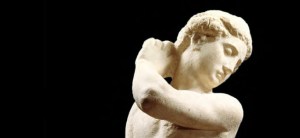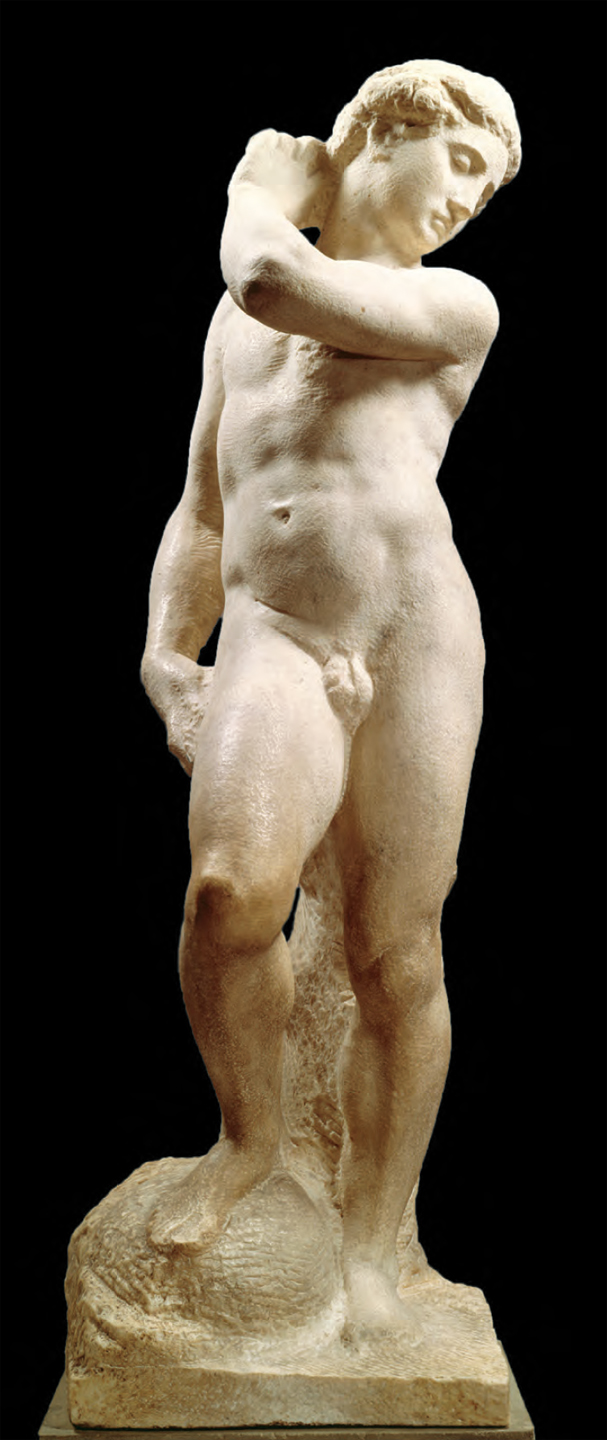Examining Michelangelo’s Unfinished David-Apollo


Michelangelo’s David-Apollo on display at the National Gallery of Art, Washington, DC on loan from the Museo Nazionale del Bargello, Florence (Photo: adapted from NGA publicity materials)
I personally love artworks with a little mystery and what could be better than an unfinished sculpture by Michelangelo? His David-Apollo is currently on display at the National Gallery of Art in DC until March 3rd, on loan from the Museo del Bargello in Florence. The sculpture is so named because there is no real consensus on whom it depicts. In 1530, Michelangelo started a small marble of David. It has been speculated that he abandoned this symbol of Florence and tried to adapt it to a classical Apollo but ultimately left the piece unfinished. To me, there is no evidence to suggest that this figure was ever meant to be an Apollo. More likely, it was a victim of Michelangelo’s legendary perfectionism. The beauty of unfinished pieces is that one can walk around them, examine the carvings and try to understand the master’s thought process up close.
Michelangelo created the David–Apollo for Baccio Valori, a Medici ally and the Governor of Florence, around 1530. Vasari suggests that the piece was abandoned for artistic reasons stating that Michelanglo “almost brought [it] to completion”[1]. It seems likely then that the sculpture was discarded before his departure for Rome in 1534.

Close up of Michelangelo’s David-Apollo at the National Gallery of Art (Photo: Bill O’Leary – THE WASHINGTON POST)
The 4 feet 9.5 inch male figure twists in a serpentine pose with his left arm and right knee twisting in opposite directions. The male nude appears to be an adult and is mostly void of any identifying iconography. Vasari described this figure as “a marble figure three arms lengths high of Apollo drawing an arrow from his quiver”[1]. Alternatively, a 1553 inventory of Cosimo I’s art collection describes it as “an incomplete David by Buonarroti”[2] who perhaps rested a sling over his back like Michelangelo’s more famous David. This is how the sculpture came to be known as the David-Apollo. The dual identification has been interpreted to suggest that the sculpture began as a David but was converted to an Apollo while in progress because Michelangelo wished to distance himself from the regional politics of Florence, which has long been associated with the biblical David. There is artistic evidence for making the David attribution at least. The mound under the right foot would have been Goliath’s head and we can imagine the figure’s relaxed posture and closed eyes as post-battle exhaustion.

The feet of Michelangelo’s David-Apollo resting on a mound that likely would have been Goliath’s head (Photo: adapted from Wikipedia)
If the likeness of David had been abandoned, surely an artist as skilled Michelangelo could have converted a relaxed David into an Apollo. However, given his known perfectionism, realizing anything less than what was imagined would surely have caused the piece to be abandoned. Michelangelo left behind several unfinished sculptures – famously his Prisoners (or Slave) series. While most sculptors slowly work the entirety of the stone to reach a rough desired form, Michelangelo frequently seemed to focused on one anatomical area bringing it to near completion before extending over the whole piece. One can imagine that upon realizing that the rest of the piece could not be actualized in the remaining stone, these pieces were abandoned. As Michelangelo reached the backside of the Apollo-David and finally had to differentiate a sling to show this was David (or quiver for Apollo), he may have been dissatisfied and realized it could not be completed. Rather than attempt a fix, he abandoned the piece which is why so much uncut stone remains on the figure’s back.

The right side and reverse of the David-Apollo showing the struggle to solve the figure’s hand placement, the carved tree stump and the remaining rough stone of the upper back. (Photo: A. Currell on flickr)
I think Michelangelo decided not to create a David, or alternatively to just abandon the piece, very late in the production of this statue. As you can see above, the left hand of the David-Apollo has been partial carved. The wrist and lower palm are clearly visible. A thin ridge of stone beside the neck suggests the strap of a sling falling down the man’s back. A large block of uncut stone along the center of the back shows that Michelangelo did not get far into the process of unequivocally differentiating the figure as David. If he had decided to create an Apollo, the last minute change may have been too challenging. To reach for an arrow from a quiver in a physiological way, the figure’s elbow and upper arm should have been placed higher such that the elbow could easily flex to pull an arrow up and out. It would also be more natural for the hand to form a fist such that the plane of the palm were perpendicular to the floor, but the figure’s left wrist has already been committed to a position roughly parallel to the floor. Even more important, Michelangelo may have been aware of Greeco-Roman statues of Artemis/Diana in which she pulls an arrow from a quiver with her right hand over her right shoulder instead of across the body like this David-Apollo. Thus the change to Apollo may have seemed both physiologically and iconographically too awkward for such a committed naturalist as Michelangelo. Lastly, a quiver strap would have need to be carved across “Apollo’s” chest which was already near completion and would have required significant reworking. [3]

Michelangelo’s David-Apollo viewed from the side showing the supportive connection points between the figure and the stump. (Photo: The Bridgeman Art Library & NGA materials)
I think Michelangelo may have given up on this statue for structural reasons. The small tree stump which supports the statue hits the figure directly in the center of the butt giving the appearance of near sitting. It cannot have been particularly satisfying for Michelangelo that a supporting element would interfere with such a large and significant portion of anatomy. As a comparison to other free standing male nudes by Michelangelo, supportive elements in David, Bacchus, and the Dying Slave are all aligned to one leg, or even to the side of the leg, and go no higher than the upper thigh. [4]
Because the figure’s knee is bend, the left leg only makes contact with the stump along the calf and is therefore structurally required to contact at the glutes to provide sufficient physical support for the marble. Looking at the back of the piece, it is evident that Michelangelo started working the stump and its fairly large connection with the figure’s anatomy. The stone defining the upper back is very rough and was likely the last aspect Michelangelo was going to work on. It’s possible that the piece was abandoned while working the stump because Michelangelo was not satisfied with the outcome. In which case, the left hand and upper back were never finished because he lost interest in the piece and not because Michelangelo was struggling with the David/Apollo identity of the figure.
I think it is interesting to consider whether Michelangelo ever envisioned this statue as Apollo. It was Vasari writing 20 years after the carving who decided that this work was an Apollo with arrows. He perhaps interpreted the large, rectangular block of stone along the back to be a quiver given its shape, without any other indication of Michelangelo’s intention. Considering some of the technical challenges speculated above involved in changing a nearly completed David into an Apollo, Michelangelo may never have considered it. He may simply have been dissatisfied with the piece for technical or artistic reasons. It would not be unheard of for Michelangelo to put considerable effort into a sculpture and then discard it when it failed to meet his expectations.
I can see along the backside of the figure where the carving and composition may have failed to achieve the artist’s vision leading the piece to be abandoned in frustration. I can even understand the arguments that Florentine politics soured Michelangelo such that couldn’t bring himself to complete another David. However, it seems less likely that Vasari’s attribution of Apollo is correct. Perhaps preliminary drawings exist (or did exist) that can show an attempt to repurpose and rework the unfinished David to something else, but there is really no evidence in the stone to suggest this conversion. It is perhaps more helpful to look at what Michelangelo did create and use this to understand his process and the challenges in realizing such a twisted figure, rather than looking for clues that this could have been something else. That being said, I’m assuming this guy will always be known as David-Apollo, burdened with the ambiguity that comes from being an unfinished masterpiece.
So what do you think? Is it David? Is it Apollo? Both, or neither?
References:
[1] Giorgio Vasari (translation by J. C & P. Bondanella), The Lives of the Artists, Oxford University Press, New York, 1998. Page 457 and notes.
[2] National Gallery of Art documentation for the piece
[3] There has been some recent news about a potential Michelangelo statue depicting a younger Cupid/Apollo with a quiver strap and slightly twisting torso. This figure carries his arrows along the back of his arm and not on the center of his back. Assuming The Young Archer is authentic, it would suggest that the David-Apollo is nearly 100% David and not Apollo. See CultureGrrl and 3Pipe Problem.
[4] Michelangelo’s Christ the Redeemer at the Church of St. Maria Minerva may be the exception here as the supportive element appears to be more like the David-Apollo but I can’t remember what the back of the statue looks like, nor can I find images of it.
See also, this Washington Post article.




Reblogged this on Art History Ramblings.
LikeLike
I’m on team David
LikeLike
🙂
LikeLike
Couldn’t he be reaching back to comb his hair?:) David seems more likely than Apollo to me, too. We can’t help but wonder and speculate, can we? Although in the end, I get kind of frustrated with it all. It’s highly unlikely that we’ll ever know more than we know now. Love your conclusion — that it’s more useful to look at and learn about Michelangelo’s sculpting process than to try to determine whether or not the figure was going to be David, Apollo, or someone else. Thanks for a nice, readable summary of the literature, with your informed and fresh thoughts interspersed.
LikeLike
Thanks Karen! I’ll have to look and see if there are any precedents for figures combing their hair. It’s an interesting interpretation! I always imagine Michelangelo struggling more with the process of producing his works because he had such grand and innovative designs he was trying to execute.
LikeLike
What a terrific, in-depth and insightful analysis. Sorry I missed this before.
Love spending this much time with an art work, considering it from all angles. Literarily so of course in the/this case of sculpture, as well as the different angles offered by various, different historical, contextual, and sometimes theoretical views.
I love your distinction between the very singular way that M worked, different to other sculptors. and the way you extrapolate from that, to the conclusion that he abandoned the work when it came to the area around the shoulder and back, to that mass of stone where the David/Apollo: sling/arrows: must go. Came to a sort of cross roads effectively, where he chose not to resolve but abandon, rather than, (if I read you right) to compromise. Anyway, super piece, as I say. Exemplary.
LikeLike